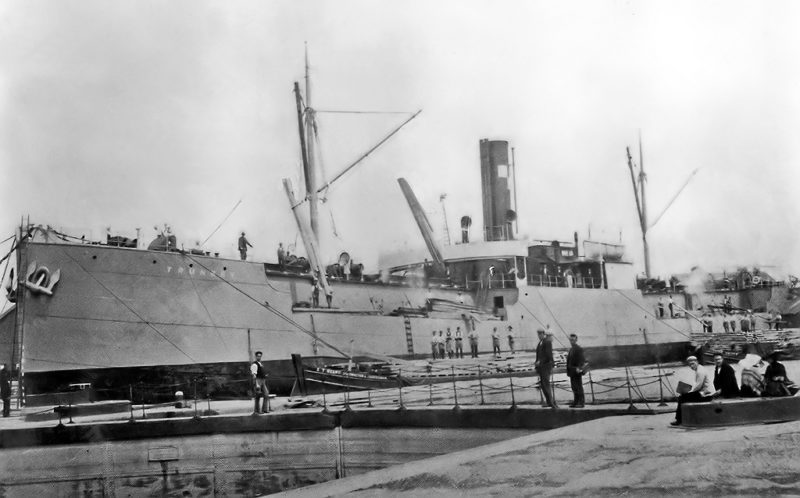
The great tramp company founded by Robert Ropner in 1874 in West Hartlepool became the largest and best known in Britain. He had been born in 1838 as the son of a German Prussian Army officer and emigrated to Britain at the age of 18 years by stowing away in Hamburg, determined on a life in the Merchant Navy. However, his ship was only going as far as West Hartlepool and after a rough North Sea passage, seasickness changed his mind and he took a job in a Hartlepool bakery. He then worked for a colliery fitting and coal exporting business in Hartlepool. After becoming a naturalised British subject, he joined the Hartlepool shipowner and coal exporter, Thomas Appleby & Company. He was made a partner in 1866 and then devoted most of his time to the shipowning side of the business. In 1874, Robert decided to branch out for himself as a shipowner and divided the fleet equally with Thomas Appleby, retaining five small steamers on Baltic trading.
These five small steamers were nearly new with the eldest dating from 1870, and a brand-new steamer delivered in July of that year was named after himself for his own account in a somewhat disguised spelling of Ropner backwards, to give Renpor. She was completed by Short Brothers at Sunderland of 2,000 dwt and was under Capt. Young for her maiden voyage but was lost eight years later to pack ice in the North Atlantic whilst on a voyage from Hartlepool to Boston with iron and potatoes. The next new tramp was Hesleden from William Gray at West Hartlepool in June 1876, followed by a near sister from the same yard, Horden in March 1877.
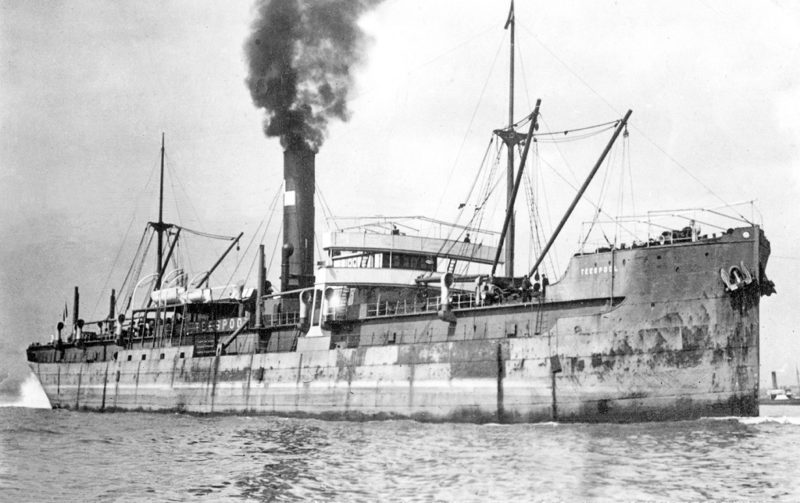
In 1879, an office was opened in Cardiff to more easily obtain coal charters from the South Wales ports, and at the end of 1880 the company owned 13 iron steam tramps, more than any other shipowner in Hartlepool. Robert also owned the largest, Elpis of 3,200 dwt, which engaged in the ‘Eternal Triangle’ trade to the Mediterranean and the Black Sea, with an occasional tea charter from China. Fifteen new tramps were launched at Hartlepool for the Ropner fleet between 1881 and 1887, with the first to have triple expansion engines being Greystoke of 1885, and the first built of steel being Wave of 1887. In that year an office was opened in London to be near the nerve centre of the chartering world, the Baltic Exchange, particularly to obtain homeward grain charters from the Black Sea.
Also in 1887, Robert Ropner purchased the Stockton shipyard of M. Pearse & Company and placed two sons, Robert and Leonard, in charge. The eldest son of ten children, John, had just been taken into partnership in the shipping office and the younger William followed in 1891. The first family built and family owned tramp was Maltby of 4,350 dwt, completed in 1889. In this respect Robert was following the earlier example of fellow townsman Christopher Furness, who had purchased the Edward Withy yard at Middleton, Hartlepool in 1883. Their shipping companies could hardly fail to make money as new ships were obtained more cheaply than their rivals, and they could also lay keels for their own fleets for later sale ‘off the peg’ to prospective shipowners at a handsome profit. The Stockton yard completed on average three new tramps per year for the family fleet as well as many more for other shipowners.

Romanby of 1887 started the naming system which continued to the end of the company. The North Yorkshire area has many villages with names ending in ‘By’, Norse for village. Romanby carried fore and aft sails, which were used on all possible occasions and also as a steadying effect in bad weather. However, sails could not prevent the loss of two tramps on their maiden voyages in 1884/85, Busby and Granby, at Pendeen Cove and lmbetipa in the River Plate respectively.
The family shipyard went on to design and build tramps of a size and draft most suitable for the ports to which charters were obtained. The most famous of these was the ‘trunk-decker’, the first example being Trunkby of 4,100 dwt and completed in November 1896. James Laing of Sunderland was also designing very similar ‘trunk-deckers’ at this time and nearly took Ropner to litigation claiming that Ropner had stolen his designs. In the next 11 years a further 22 ‘trunk-deckers’ were completed by the family shipyard for the family fleet. They had a steel trunk built on the main deck, which in the first examples did not run the full length of the ship but stopped on either side of the ‘midships’ structure.
These ‘half trunk-deckers’ were later superseded by ‘full trunkdeckers’, which were very similar to the Doxford built ‘Turrets’. In fact, the only differences between the two types was the rounded gunwhale on the harbour deck of the ‘Turret’, and the almost square stern of the ‘trunk-decker’. The final example for the family fleet was Romanby of 6,100 dwt, completed in 1908, but another 22 examples had been built for other owners, with 4 for Watts, Watts and 4 for Evan Thomas Radcliffe during 1896/98.
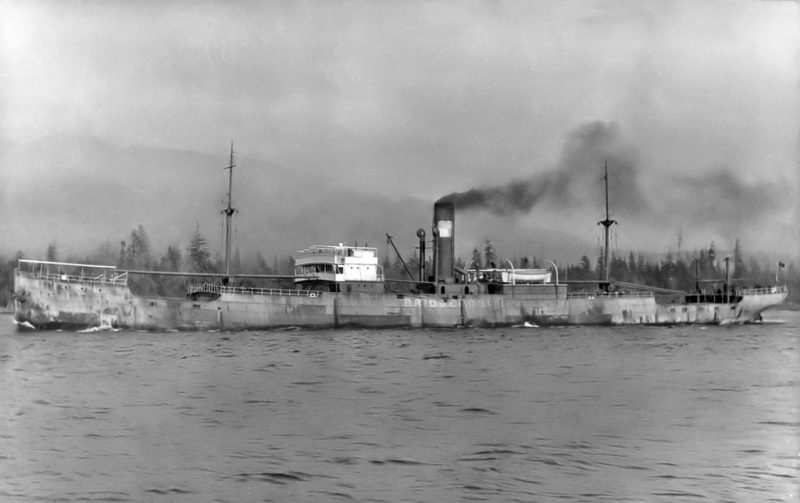
At the turn of the century, the Ropner fleet consisted of 34 deep-sea tramps, including the new sisters Daleby and Dromonby of 5,000 dwt and Glenby of 3,300 dwt, completed that year by the family shipyard. Shortly afterwards tramps with names with the suffix ‘Pool’ began to make their entry into the fleet position lists. In 1903, the Pool Shipping Co. Ltd. was formed with a nominal capital of £250,000 of which about half was issued, many shareholders being in the Yorkshire and Lancashire woollen and cotton industries. Heronspool was the first tramp for the new company in September 1903, followed by Troutpool in November and Hartlepool in January 1904. Hartlepool was to have an interesting career with the company, surviving WWI and being converted in 1918 into the first tanker owned by the company by fitting cylindrical tanks into her holds. Four years later she was purchased by the Anglo-Saxon Petroleum Co. Ltd. and renamed Purpura. The first three tramps for the Pool Shipping Co. Ltd. were over 6,000 dwt, and it became practice for the larger tramps with their consequent bigger bunker capacity to be registered under this company for deep-sea trading to the River Plate, Australia and the Pacific islands.
Levenpool of 1911 was a big jump forward in carrying capacity at 8,750 dwt and was a long bridge type of tramp, which under Lloyds’ rules allowed greater carrying capacity. Freight rates had improved considerably from the low rates obtainable in 1908, and Levenpool was given a large cross-bunker hold to enable her to carry larger amounts of bunker coal for long voyages to Australia for grain and to Chile for nitrate.

Her smaller consorts usually plied with coal to the Mediterranean, bringing home iron ore from North Africa, or perhaps loading salt at Port Said for Calcutta and then sailing to Java to load sugar. Another frequent variation was coal to the Mediterranean, iron ore from North Africa to the U.S.A., case oil to Japan and back across the Pacific to Vancouver for lumber for piling for the Panama Canal then under construction. A homeward cargo of nitrate might be picked up in Chile, or grain in the River Plate and the crew would arrive home after a voyage of 18 months or more.
Robert Ropner had been knighted in 1902 and represented Stockton in Parliament between 1902 and 1910. The name of the management company was changed to Sir R. Ropner & Co. Ltd. in 1915, by which time his company was managing a fleet of 57 tramps and 350,000 dwt. Soon the first of 23 company owned tramps was to be sent to the bottom of the sea by the enemy:-
20.2.1915 Willerby – Captured & sunk S of Cape Verde Islands by raider Prinz Eitel Frederick
23.2.1915 Oakby – Torpedoed & sunk 4 miles NE of Royal Sovereign L.V. by U-8 on a voyage from London to Cardiff in ballast
27.3.1915 Coleby – Captured & sunk by raider Kronprinz Wilhelm 460 miles NE of Pernambuco
1.7.1917 Gadsby -Torpedoed & sunk 33 miles SSW of Wolf Rock by U-39 on a voyage from Sydney (NS) to London with wheat
17.8.1915 Glenby – Sunk by gunfire from U-38 30 miles N of Smalls in St. George’s Channel on a voyage from Cardiff to Archangel with coal, 2 lost
17.8.1915 Kirkby – Torpedoed & sunk by U-38 23 miles SW of Bardsey Island on a voyage from Barry with coal
6.10.1915 Scawby – Sunk by bombs after being captured by U-33 220 miles E of Malta on a voyage from Mudros to Malta in ballast
13.1.1916 Dromonby – Captured & sunk by raider Moewe 220 miles W of Lisbon
28.2.1916 Thornaby – Mined & sunk 2 miles NE of Shipwash L.V. by mines laid by U-C3 on a voyage from Marbella to Hartlepool with iron ore, 19 lost
27.5.1916 Trunkby – Sunk by gunfire 50 miles SE of Port Mahon by U-39 on a voyage from Newport to Cette with coal
1.6.1916 Salmanpool – Torpedoed & sunk 30 miles ENE of Cape Carbon by U-39 on a voyage from Naples to Baltimore in ballast
4.1.1917 Wragby – Sunk by gunfire 45 miles NW of Cape Spartel by UC-37 on a voyage from Barry to Gibraltar with coal
14.1.1917 Martin – Sunk by gunfire 8 miles NW of Ushant by UC-18 on a voyage from Bayonne to Barry with pitprops
26.2.1917 Burnby – Torpedoed & sunk 20 miles N of Cape Falcon by U-39 on a voyage from Barry to Algiers with coal
29.4.1917 Daleby – Torpedoed & sunk 180 miles NW of Fastnet by U-70 on a voyage from Huelva to Garston with copper and silver ore, 26 lost
15.6.1917 Westonby – Torpedoed & sunk 195 miles SSW of Fastnet by U-82 on a voyage from Huelva to London with pyrites and lead
19.6.1917 Brookby – Torpedoed & sunk 155 miles SSW of Fastnet by U-60 on a voyage from Sagunto to the Tees with iron ore
2.7.1917 Thirlby – Torpedoed & sunk 122 miles WNW of Fastnet by UC-31 on a voyage from Bonanza to Garston with copper ore, 2 lost
15.9.1917 Rollesby – Torpedoed & sunk 80 miles ENE of Muckle Flugga by U-48 on a voyage from Cardiff to Archangel with coal
26.2.1918 Maltby – Torpedoed & sunk 10 miles SSW of Pantellaria Island by UC-27 on a voyage from Cardiff to Malta with coal, 5 lost
2.3.1918 Rockpool – Torpedoed & sunk 12 miles NNE of Eagle Island by U-94 on a voyage from New Orleans to Dublin with wheat and steel
10.6.1918 Mountby – Torpedoed & sunk 8 miles SE of The Lizard by UC-49 on a voyage from Swansea with Admiralty cargo
28.9.1918 Baldersby – Torpedoed & sunk 9 miles SE of Codling Bank L.V. in St. George’s Channel by UB-91 on a voyage from Montreal to Avonmouth with grain, 2 lost
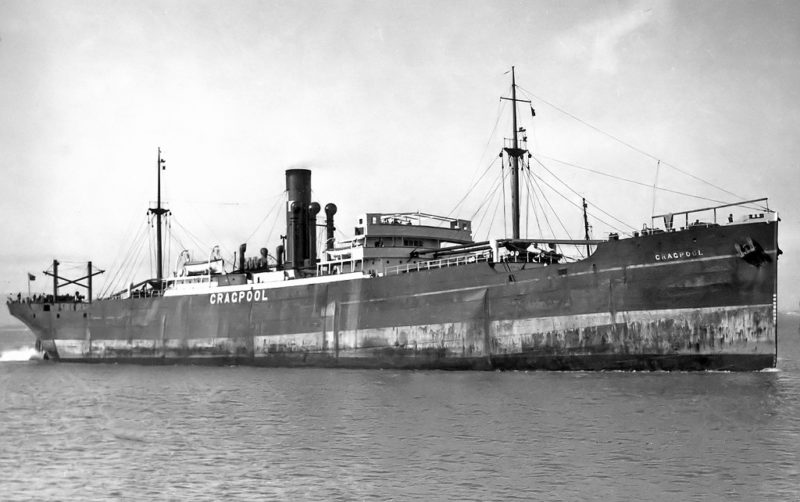
The Pool Shipping Co. Ltd. lost only two tramps, and this is accounted for by the fact that they were out of the submarine activity area around Great Britain for much longer periods of time. While the treatment meted out to the crews of Willerby and Coleby by the surface raiders was civilised with time being given to pack their bags, a receipt handed to the Master, and then all safely landed in the U.S.A., the crew of Glenby was subjected to a vicious machine gunning while in the lifeboats with two dead and two seriously wounded.
Wandby under Capt. D. Simpson fought a heroic action against a U-boat in the Bay of Biscay on 2nd April 1917. Wandby was on passage from Bilbao to La Rochelle in heavy weather when the U-boat, armed with two 4″ guns, started shelling. Due to the heavy seas, it was some time before the U-boat was sighted, and then course was altered to put her astern and fire was commenced from the aft gun. The accuracy was high and after only 15 shells a direct hit was obtained on the U-boat and she sank by the stern and then disappeared with her bow high in the water. Wandby had received just one hit from 36 shells fired by the U-boat, and Capt. Simpson received the O.B.E. from the King, and Lloyd’s Silver Medal, and a gold medal and diploma from the Shipping Federation. Monetary awards were made to the First Mate and two other crew.
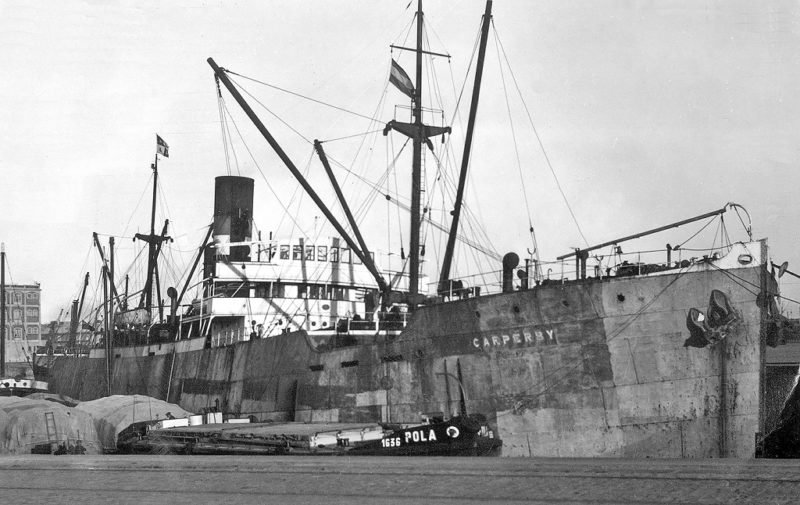
Thirlby under Capt. T.M. Hill went into action against a U-boat at about the same time, again in the Bay of Biscay. A torpedo fired by the U-boat missed the tramp, and by careful handling by Capt. Hill two more were evaded. The U-boat then surfaced and opened fire with her guns, to which Thirlby replied with her 4 inch gun. It was a long action of four and a half hours with 150 shells fired by the U-boat but only one hit scored on the tramp. At last, a direct hit was obtained on the conning tower of the U-boat, and she promptly put about and fled on the surface at high speed. Capt. Hill was awarded a gold medal and diploma by the Shipping Federation, and silver medals were awarded to First Mate Jackson, Chief Steward Wake and crew member W. Sheriff, only 17 years of age at the time.
Capt. Hill transferred to the Pikepool and she was torpedoed on 14th February 1918 at the after end of no. 2 hold and the stokehold and engine room were also flooded, but the crew managed to keep the tramp afloat and she was towed into Portland Harbour. Both Capt. Hill and Capt. Simpson went on to serve in WWII, both unfortunately losing their lives.
A managed ship was also sunk by the enemy and other casualties during WWI were Hawnby wrecked near Montrose with the absence of shore lights blamed for her loss, Ashby wrecked near Ushant L.H., Romanby to a collision in the North Atlantic, and Teesdale foundered 3 miles N of Saltburn Pier just short of the Tees, to which she was heading for repairs after being torpedoed in the Channel and beached off Salcombe.
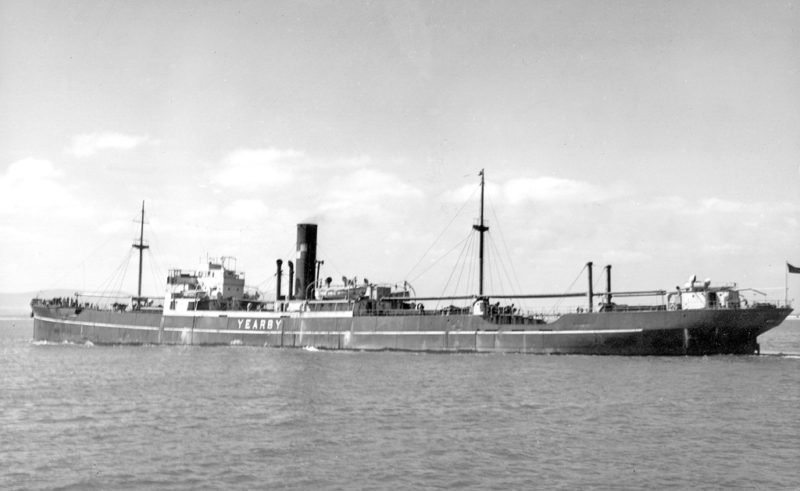
Two new tramps had been built but this left only 26 tramps in the fleet at the end of the war, with 13 having ‘Pool’ names and 13 having ‘By’ names.
This latter set were still under the 64ths principle and were transferred in 1919 to a newly formed company, Ropner Shipping Co. Ltd., with an issued capital of £1.3 million. Also in 1919, Haxby was sold to the Britain S.S. Co. Ltd. (Watts, Watts) and renamed Finchley, and Yearby was sold to M.H. Bland of Gibraltar.
Owing to the severe slump in the early 1920s following the immediate post-war boom, it was not until June 1923 that the first post-WW1 tramp was completed at the family shipyard at Stockton, the Roxby. She was followed by Bridgepool, Reedpool and Drakepool in 1924 and then the final tramp from the family yard, Willowpool in May 1925, the last of 72 tramps built by the yard for the family fleet.
The yard was then sold by the family after the death of Sir Robert in 1924 at the age of 86 years, and it was demolished a few years later to reduce national capacity. By this time four grandsons had joined the management team, Leonard, Guy, Jock and Robert.

Three tramps were wrecked in the early 1920s, Wandby off Portland (ME) whilst on a voyage there from Genoa in ballast, Troutpool to South of St. Pierre, Miquelon whilst on a voyage from Las Palmas to St. John’s (NF) and Somersby on the Baldayo Bank near A Coruña whilst on a voyage from Cardiff to Civitavecchia with coal. They were replaced in a large programme of 30 steam tramps completed between 1925 and 1936:-
30 STEAM TRAMPS OF 8,650-10,295 DWT
WJ Gray (23)
Rudby, Ainderby, Firby, Warlaby, Romanby, Thirlby, Carperby, Lackenby, Haxby, Yearby, Somersby, Domby, Otterpool, Troutpool, Rockpool, Ullapool, Mansepool, Hindpool, Heronspool, Swiftpool, Deerpool, Clearpool, Hawnby.
Cowpen DD (4) Ashby, Gullpool, Cragpool, Rushpool
J.Laing (1) Kirkpool
Smiths Dock (2) Stonepool, Boulderpool
They were well deckers, with one well-deck up forward and the other aft, and coal-fired furnaces raised steam for triple expansion engines. Oil-fired furnaces under the boilers were being tried by other owners, but an experiment of a different sort was tried in Swiftpool of 1929 using pulverised coal injected in the same way as fuel oil. This would of course save all trimming costs and some firemen, and the idea had been tried successfully with shore-based boilers. However, after two voyages in Swiftpool with great difficulties in obtaining supplies of pulverised coal in foreign ports, it was obvious that this type of fuel for raising steam did not have a future. However, anything that might save money during the Depression had to be tried, with two turbine-driven tramps, Clearpool and Hawnby, being completed towards the end of 1935/36. Both became war losses, and the lack of economy of the turbine in the competitive tramp charter market ensured they were never subsequently used again.
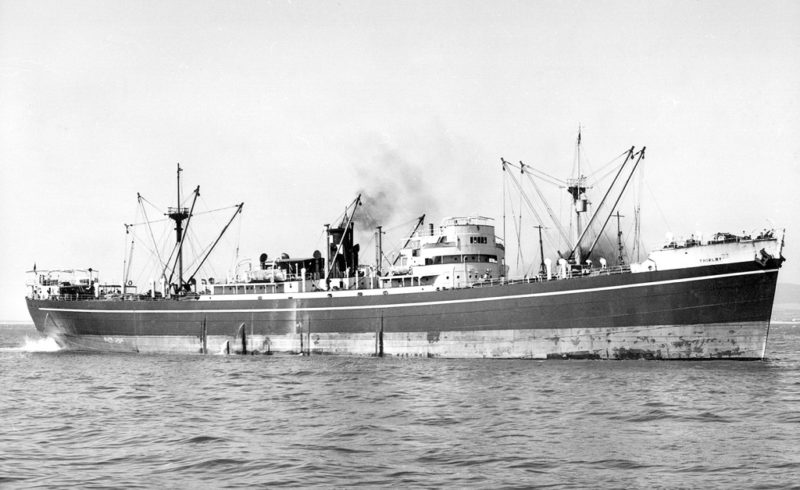
The finances of the largest British tramp company were sorely tested during the Depression, with the dividends and management commission suspended until after 1936. Most of the fleet was kept going with waits at the end of each voyage for the next charter, although Holtby was laid-up at Jarrow for nine months during 1932/33 and a dozen other Ropner tramps were laid-up at the same time for shorter periods. However, they traded at a loss and the combined trading result of the two companies in 1934 with 48 tramps (29 ‘Pool’s and 19 ‘By’s) was a profit of £25,780 without taking into account repairs, depreciation etc. One solution was to issue clearance papers for countries bordering North and South America and South Africa and to sail tramps out into the Atlantic at slow speed, allowing the company to say they had a ship en-route to a particular country when a cargo offered on the Baltic Exchange.
Saxilby under Capt. B.J. Samuel was lost some 400 miles off West coast of Ireland in a severe storm on 15th November 1933. An extensive search was made but no trace of the ship or her 28 crew was found. Millpool under Capt. Newton was similarly lost in North Atlantic on 3rd October 1934 while on a voyage from Danzig to Montreal with grain, her after hatch stove in, main topmast gone, and three men injured. Later, the mainmast crashed through the deck and her engine room started to flood and she sank with the loss of all hands.

The pair of economical standard Doxford motor tramps, Moorby and Wearpool of 9,100 dwt, completed during 1936 set the tone for the economy minded late 1930s. The fleet was still the largest in Britain at 46 tramps of over 400,000 dwt on the outbreak of WWII, but was to be decimated by the enemy, with 33 sunk due to war reasons and three lost to marine causes:-
11.9.1939 Firby – Torpedoed & sunk by U-48 to SW of Faroes on a voyage from Tyne to Port Churchill in ballast
13.10.1939 Heronspool – Torpedoed & sunk by U-48 off SW Ireland on a voyage from Swansea to Montreal with coal
10.12.1939 Willowpool – Mined & sunk 3 miles E of Newarp L.V. on a voyage from Bona to the Tees with iron ore

9.4.1940 Romanby – Sunk alongside at Narvik quay, part-loaded with iron ore
15.4.1940 Salmonpool – Seized at Saudafjord in Norway
17.4.1940 Swainby – Torpedoed & sunk by U-13 25 miles from Muckle Flugga on a voyage from Maaloysund to Kirkwall in ballast
20.4.1940 Hawnby – Mined & sunk off Thames Estuary on a voyage from the Tyne to Genoa with coal
24.4.1940 Haxby – Shelled & sunk by raider Orion in North Atlantic on a voyage from Glasgow to Corpus Christi in ballast, 17 lost
20.6.1940 Otterpool – Torpedoed & sunk by U-30 in North Atlantic on a voyage from Bona to the Tees with iron ore, 23 lost
20.7.1940 Troutpool – Mined & sunk in Belfast Lough, 11 lost
19.10.1940 Wandby – Torpedoed & sunk by U-46 & U-47 to NW of Rockall on the homeward leg of her maiden voyage from Victoria (BC) with lumber, lead and zinc
19.10.1940 Sedgepool – Torpedoed & sunk by U-99 W of the Hebrides on a voyage from Montreal to Manchester with wheat, 3 lost
22.11.1940 Pikepool – Mined & sunk 23 miles ESE of Smalls Light on a voyage from Glasgow to Barry in ballast, 17 lost
29.1.1941 Rushpool – Torpedoed & sunk by U-94 in North Atlantic on a voyage from St. John (NB) & Halifax to Belfast with grain
12.2.1941 Warlaby – Shelled & sunk by Admiral Hipper to E of the Azores on a voyage from Alexandria to Oban with meal, cotton seed & oil cake, 37 lost
24.2.1941 Mansepool – Torpedoed & sunk by U-97 near Faroes on a voyage from Cardiff to Halifax in ballast, 2 lost
7.3.1941 Boulderpool – Torpedoed & sunk by E-boat off Norfolk coast on a voyage from London to Tyne in ballast
8.3.1941 Hindpool – Torpedoed & sunk by U-124 off West Africa on a voyage from Pepel to Oban & the Tees with iron ore, 28 lost
13.3.1941 Ullapool – Mined & sunk in the Mersey, 16 lost
3.4.1941 Alderpool – Torpedoed & sunk by U-46 in North Atlantic on a voyage from New York to Hull with wheat
13.5.1941 Somersby – Torpedoed & sunk by U-111 off SW Ireland on a voyage from Halifax to Loch Ewe with grain
10.6.1941 Ainderby – Torpedoed & sunk by U-552 in North Atlantic on a voyage from Santos to the Tyne with iron ore, 12 lost
5.8.1941 Swiftpool – Torpedoed & sunk by U-372 to west of Ireland on a voyage from Pepel & Freetown to the Tees with iron ore, 42 lost
11.9.1941 Stonepool – Torpedoed & sunk by U-207 to east of Greenland on a voyage from Montreal to Avonmouth with oats, grain and trucks, 42 lost
30.11.1941 Ashby – Torpedoed & sunk by U-43 in North Atlantic on a voyage from the Tees to Freetown & Pepel in ballast, 17 lost
23.1.1942 Thirlby – Torpedoed & sunk by U-109 to 12 miles S of Cape Sable on a voyage from New York to Halifax & Loch Ewe with maize, 5 lost
1.3.1942 Carperby – Torpedoed & sunk by U-588 in West Atlantic on a voyage from Tyne to St. Thomas & Buenos Aires with coal & coke, 41 lost
10.4.1942 Kirkpool – Shelled & sunk by raider Thor in South Atlantic on a voyage from Durban to Montevideo with coal, 18 lost
20.9.1942 Reedpool – Torpedoed & sunk by U-515 150 miles N of Georgetown British Guiana on a voyage from Massowah & Table Bay to Trinidad & Fernandina in ballast, 6 lost
4.11.1942 Daleby – Torpedoed & sunk by U-89 in North Atlantic on a voyage from Halifax to London with grain and tanks
7.11.1942 Roxby – Torpedoed & sunk by U-613 in North Atlantic on a voyage from Cardiff & Greenock to Halifax with coal, 34 lost
25.1.1943 Lackenby – Torpedoed & sunk by U-624 in North Atlantic on a voyage from Tampa & New York to Loch Ewe & London with phosphate, 45 lost
26.7.1943 Fishpool – Blew up after air attack at Syracuse, Sicily having arrived from Alexandria with ammunition, 28 lost
638 brave men had died on company ships. 28 men were decorated for bravery
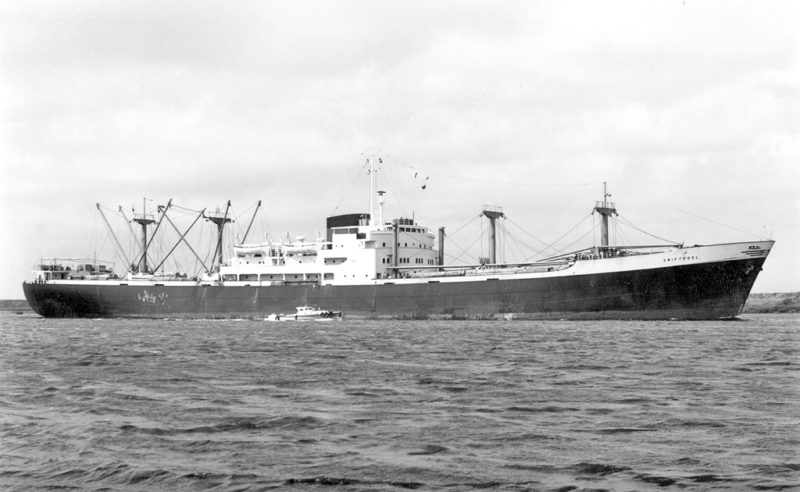
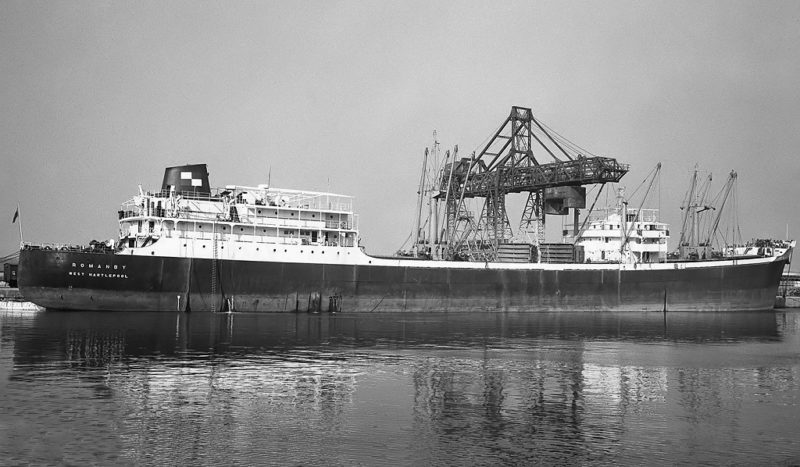
The marine losses were Deerpool near Spurn Point, Rockpool on Little Cumbrae Island, and Clearpool on the Skitter Sands in the Humber. A separate chapter could be written on the WWII exploits of ‘Ropner’s Navy’. However, the disabling of two U-boats leading to their loss by Stonepool and Rockpool go down in the annals of history as deeds of great bravery. Both occurred on the same day, 13th October 1939, and Stonepool under Capt. A. White had broken away from her convoy to make her own way south to the Cape Verde Islands with coal. U-42 fired a torpedo which missed, and then Stonepool put her astern and a gun duel ensued, and with her fifteenth shell from her aft 4″ gun the U-boat was disabled and was scuttled when a destroyer appeared. Rockpool under Capt. W.H. Harland was in a convoy of ten ships out of Newfoundland and loaded with ore and battling against a full Atlantic gale. In the Western Approaches, Rockpool had fallen astern and was alone when a furious gun battle was fought with U-40 at around 1300 hours resulting in a hit on U-40 from her 13 rounds fired. The disabled U-40 was sunk by a destroyer, and Rockpool made off to safety under cover of smoke screens.
Some fifty ‘Empire’ or other standard ships were managed by the company during or shortly after the war and eight of these were sunk by the enemy. Only eleven pre-war survivors of the war holocaust returned to trading in Bridgepool, Drakepool, Gullpool, Cragpool, Stagpool, Wearpool, Seapool, Yearby, Domby, Moorby, and Danby. The gaps in the fleets were initially plugged by purchasing fifteen standard war-built tramps, six ‘Empire’s, six ‘Ocean’s and three ‘Liberties’, and the company continued the management of six ‘Fort’ types after the war on bare boat charter to the Ministry of War Transport. Fort Stager and Yearby were trading to Australia during 1946, with Yearby on charter to Broken Hill Proprietary Ltd. (BHP) for coastal voyages. The Ropner Shipping Co. Ltd. in post-war years had eight directors, of which five Ropner family directors lived in the Bedale area of North Yorkshire.
A new liner service to the Gulf of Mexico from European ports was inaugurated by Moorby when she sailed from Hull on 28th September 1946, and she was joined by Teespool, an ‘Ocean’ type, shortly afterwards. Many of the standard types were converted to oil-firing in 1949, but general cargo carrying required ‘tweendeckers and the post WWII replacement programme got under way in the Spring of 1950 at the Sir James Laing shipyard in Sunderland with the launch of Daleby. She was resplendent in green paint as the first new ship to have a hull colour of bottle green. The rest of the fleet had changed to bottle green hulls and funnels in 1946.
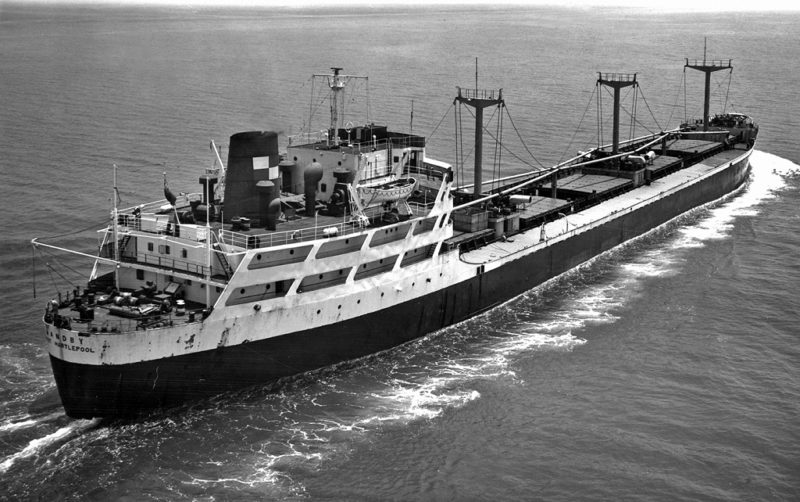
5 CARGO-LINERS OF 7,770-10,200 DWT FOR U.S. GULF SERVICE
J.Laing (3) Daleby, Deerpool, Somersby
Caledon SB (1) Swiftpool
J.L. Thompson (1) Troutpool
Daleby was commanded by Capt. John Kenny and Deerpool by Capt. C.H. Churchill and they were fitted to carry 12 passengers accommodated ‘midships with the Master and officers, while the crew were housed aft. The passenger accommodation was very well appointed for the twelve day voyage to Gulf and Mississippi ports, with mechanical heating and ventilation installed. A four-cylinder Doxford oil engine was installed in the first pair to give 13.5 knots, and increased to a six-cylinder version in the last trio giving 15.5 knots. The first pair cost £0.5 million each, but were economical to run with a fuel consumption of 10 tons per day of diesel oil. The liner service ships had yellow funnels with a different logo to the red and white chequerboard of the main fleet.
However, by the time Troutpool was completed in early 1956, the company was starting to withdraw from the liner service due to competition and a desire to return to traditional bulk cargoes. Somersby under Capt. John Kenny completed her final voyage as a cargo-liner in midsummer 1956 and then sailed from London to Galveston to load bulk sulphur for Leith and Immingham. She then dry-docked at Cardiff and was requisitioned by the Government to carry military stores to the Mediterranean in connection with the Suez crisis. The lucky crew spent six weeks sunning themselves in Malta before it was decided their cargo was not wanted and she discharged at Gibraltar. She headed back to the U.S. Gulf and loaded bagged sugar in Cuba for U.K. ports, and after a repeat voyage, was sold to the Admiralty for conversion into an Air Store Support ship. She was dry-docked at Smiths Dock Co. Ltd. at North Shields and began service with the Admiralty in August 1957 under her Ropner name of Somersby. The full conversion began at North Shields in February 1958 and was completed in September of that year and she was renamed Reliant at Rosyth.

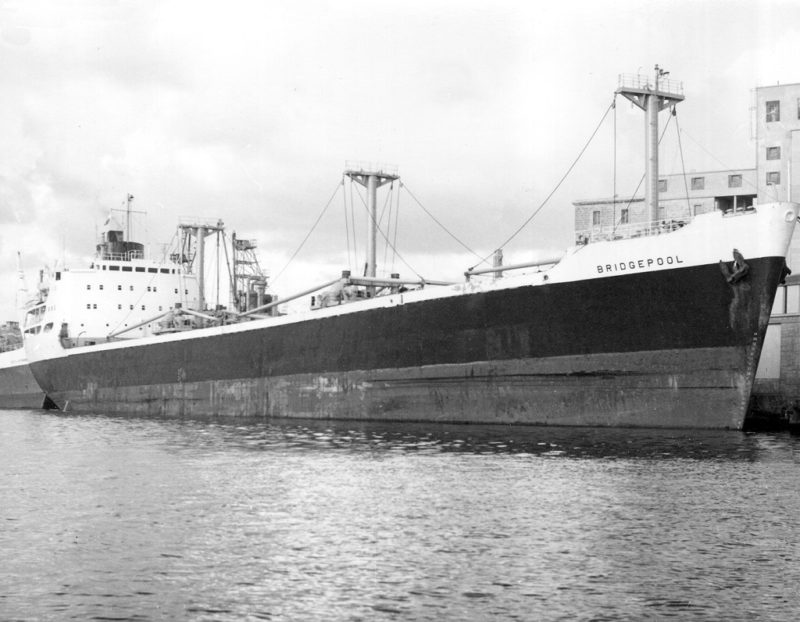
The other former cargo-liners were taken on charter by liner companies to West Africa e.g. Elder Dempster or Guinea Gulf Line (Holt). Daleby acted as a cadet-ship with the twelve apprentices housed in palatial surroundings in the former passenger accommodation. She was fitted with car-decks in 1959 at Lubeck to participate in the growing car export trade to North America, returning with grain. Willowpool with engines ‘midships was specially developed for this service when completed in March 1960 in Sweden. She was a five hold closed shelterdecker fitted out with extra decks for the carriage of over 700 cars, and for the voyage home with grain it was possible to leave the car decks in position. If she changed to other cargoes, the bolted construction of the car decks made it relatively simple to dismantle them, and her six cylinder Gotaverken oil engine gave a loaded service speed of 14 knots.
The tanker trades were re-entered in June 1955 with the completion of the 18,270 dwt Thornaby by Laing for a five year charter to BP, and she was joined by the slightly larger 21,000 dwt Thirlby, launched at the same yard on 2nd May 1958 for a bareboat charter to Shell. Engines had also been moved aft in 1957 with the delivery of dry-cargo Romanby and Rushpool of 14,480 dwt from the same shipyard. Romanby was chartered for five years to Vulcaan of Rotterdam. Wandby of October 1959 was the first bulker to have everything aft. Rushpool was named after the Neo-Gothic Rushpool Hall at Saltburn, built in 1861 by John Bell of Bell Brothers Mining for £100,000 and is now a hotel.
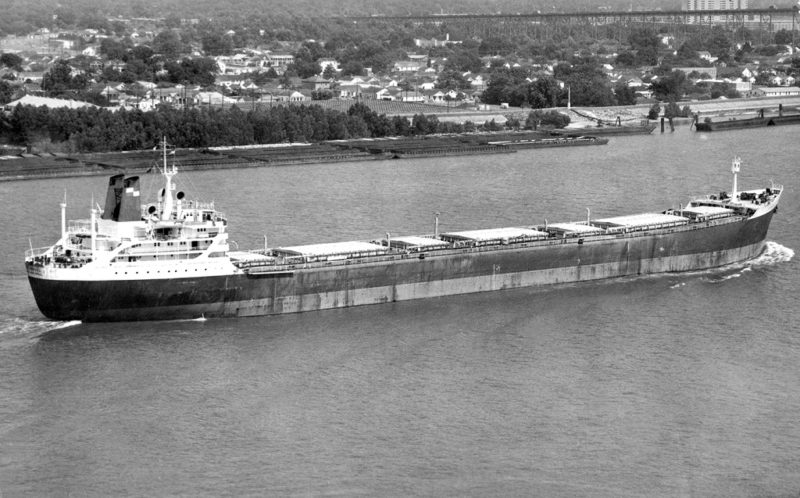
The last pair of standard war-built tramps, Levenpool and Swainby, were sold to London Greeks in 1962, all their sisters having been sold out of lay-up in 1959/60 after entering lay-up in 1958 on a disastrous fall in freight rates. Seven standard war-built types were laid-up in 1959 out of a fleet of 16.
The last engines ‘midships tramp, Willowpool, was sold in 1967 to leave a fleet of seven bulkers with a carrying capacity of 154,320 dwt, or the equivalent of a fleet of 20 pre-WWII tramps. The twin funnelled Stonepool of 45,000 dwt was the flagship, and she was the first order that Ropner had ever placed with a Clyde yard, Charles Connell & Co. Ltd. for delivery in June 1966. Ropner Management Ltd. won an important contract in 1969 to manage the 22,000 dwt bulker Norse Viking then under construction for the Cardigan Shipping Co. Ltd. This company was purchased ‘off-the shelf’ by an Anglo-Norse consortium of Harrisons (Clyde) Ltd., Ropner Management Ltd. and Fred. Olsen’s Blandford Shipping Co. Ltd. The first of a series of four giant bulker/ore carriers was named Rudby at her launch at the Belfast yard of Harland & Wolff Ltd. on 11th December 1970 for charter to the Norwegian Bulk Carriers consortium of Skaugen, Ruud-Pedersen, Morland and Tonnevold owners:-
4 BULKER/ORE CARRIERS OF 105,000-119,500 DWT
Harland & Wolff (4) Rudby, Iron Somersby, Lackenby, Appleby
Rudby traded with iron ore and bulk cargoes for European steel producers, and even arrived in the Tyne on one occasion for repairs afloat, although too big for dry-docking.

The second bulker was named Iron Somersby when taken on bare-boat charter by Broken Hill Proprietary (BHP) to carry iron ore from Port Hedland to Port Kembla (NSW) in December 1971, but used Australian crews and not Ropner seafarers. The third bulker was launched as Otterpool in 1977 for Norwegian Bulk Carriers but completed as Lackenby on a fifteen year charter to British Steel, at the end of which she were sold to British Steel. Appleby was purchased from a Norwegian shipowner for a similar charter in 1978, and a fifth sister Ravenscraig was completed in 1979 owned by British Steel but managed by the company. All five giant ships had 9-cylinder B&W oil engines by the shipbuilder to give a loaded service speed of 15 knots.
Rudby was sold to Liberian owners in 1980, and Thirlby completed a magnificent 23 years of service with the company in 1981 and was sold to Greek interests. Stonepool arrived at Tilbury on 28th December 1982 at the end of her last company voyage, having been sold to Liberian owners who retained her name, which she proudly carried to the breakers at Kaohsiung in September 1986. Salmonpool of 45,000 dwt was purchased on the stocks at the Eleusis Shipyard in Greece and had been building for some time before completion in March 1982. She then suffered some misfortunes and made only one commercial voyage that year before being laid-up at Glasgow. Repeat charters to Salen of Sweden soon improved her profitability and she was sold in February 1990 for $12 million to Fearnley & Eger of Oslo for use in the U.K. aggregates trades.
Iron Kestrel and Iron Ferry of 26,843 dwt were purchased from Greek Kulukundis interests in early 1982 while already on bare-boat charter to Broken Hill Proprietary of Australia.
They had been built as five hold geared bulkers with four deck cranes in Japan in 1974 for operation in the ‘Star’ consortium. Iron Kerry was renamed Iron Kirby, and they were used for carrying BHP export steel products from Port Kembla (NSW) and Newcastle (NSW) to China, Philippines, Singapore, Hong Kong, Japan and Taiwan and occasionally to the Persian Gulf. They returned with either limestone from Japan or iron ore from Yampi or Port Hedland. They also coasted with steel products to Tasmania, from where the cost of ballast voyages was later defrayed by back-loading ferro-silicon in no. 1 hold in Iron Kirby.
However, from 1987 Iron Kirby operated a container, steel products and bulk service between Australia and New Zealand for BHP. Iron Kestrel was sold for $5.75 million in March 1990 but second-hand prices had slipped a year later in March 1991 when Iron Kirby was sold to Greek interests for only $3.9 million, both having completed their BHP charters.
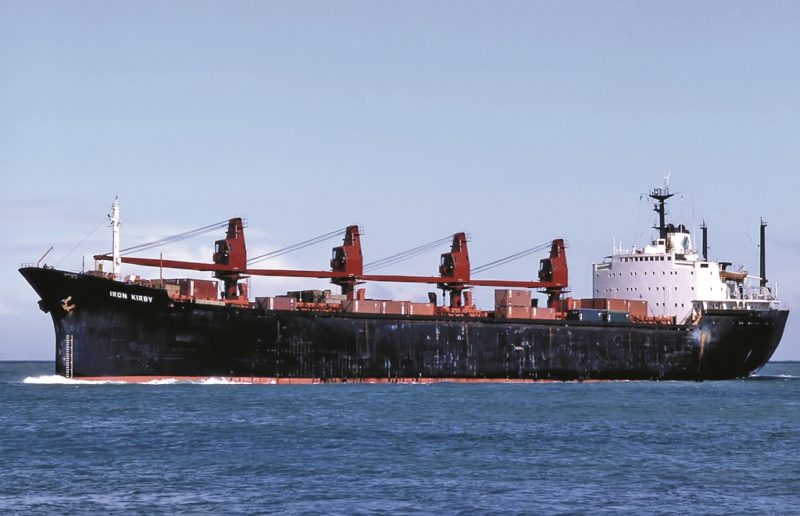
The sale of Iron Kirby marked the end of a twenty year relationship with BHP which had begun with the delivery of Iron Somersby in December 1971.
Iron Somersby regained her Ropner name of Somersby in 1985 at the end of her BHP charter, her first Ropner crew then sailed under Bahamian registry until she was sold a year later to Chinese owners as Chia Yun.
The 61,737 dwt bulker United Ace was purchased at the end of 1990 from Worldwide Shipping with delivery at Nagoya in Japan, and she was renamed Otterpool. She was taken on charter by Cargill International for a series of voyages from Buenos Aires to Liverpool with grain.
An important management contract was won to manage two 96,725 dwt self-unloading ore-carriers for British Steel and building in Japan.
Western Bridge was handed over on 21st January 1991 and sailed via Singapore to load at Saldanha Bay for Port Talbot, and then carried coal or iron ore from Almeria, Seven Islands and Newport News to Port Talbot. Eastern Bridge was handed over on 30th April 1991 and sailed via Singapore to Saldanha Bay to load for Port Talbot. The larger fleet mates of Lackenby, Appleby and Ravenscraig supplied the Tees and lmmingham with iron ore and coal, and kept alive the proud Ropner tramping tradition, still family controlled from Darlington by the great-grandsons of the founder.
Two further bulkers similar in size to Otterpool were purchased in 1992 and 1995 and renamed Oakby of 64,197 dwt and Deerpool of 65,161 dwt, both having been built in 1982/83.
This trio traded worldwide with Argentinean grain, Murmugao ore and Australian coal until 1996/97, when each was sold for £6.25 million to new owners and renamed for further service.
Ropner then continued in business as ship managers when taken over by Jacobs Holdings PLC later in 1997. In Millennium year, the company moved to Dartford in Kent and became a unit of Bidcorp Shipping Division, which was rebranded as Dart Line Ltd. in 2005 with ro-ro vessels.
On 1st March 2006, Ropner Ship Management ceased to trade as a ship management company, with its former business then performed by EuroShip Services Ltd.

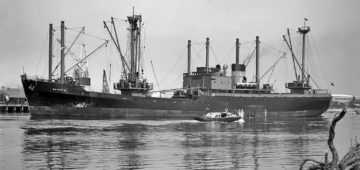



Comments
Sorry, comments are closed for this item